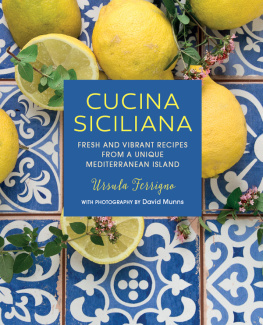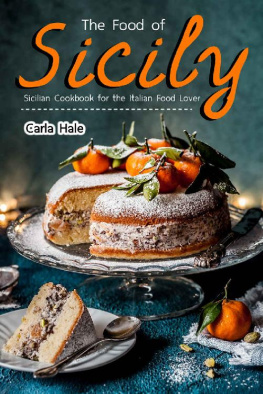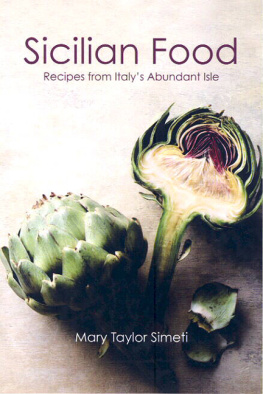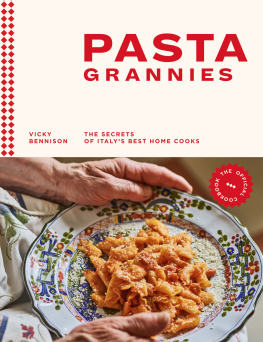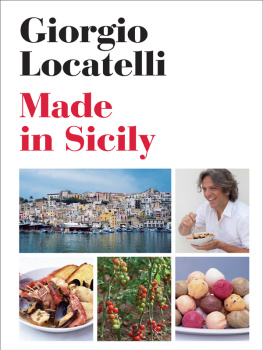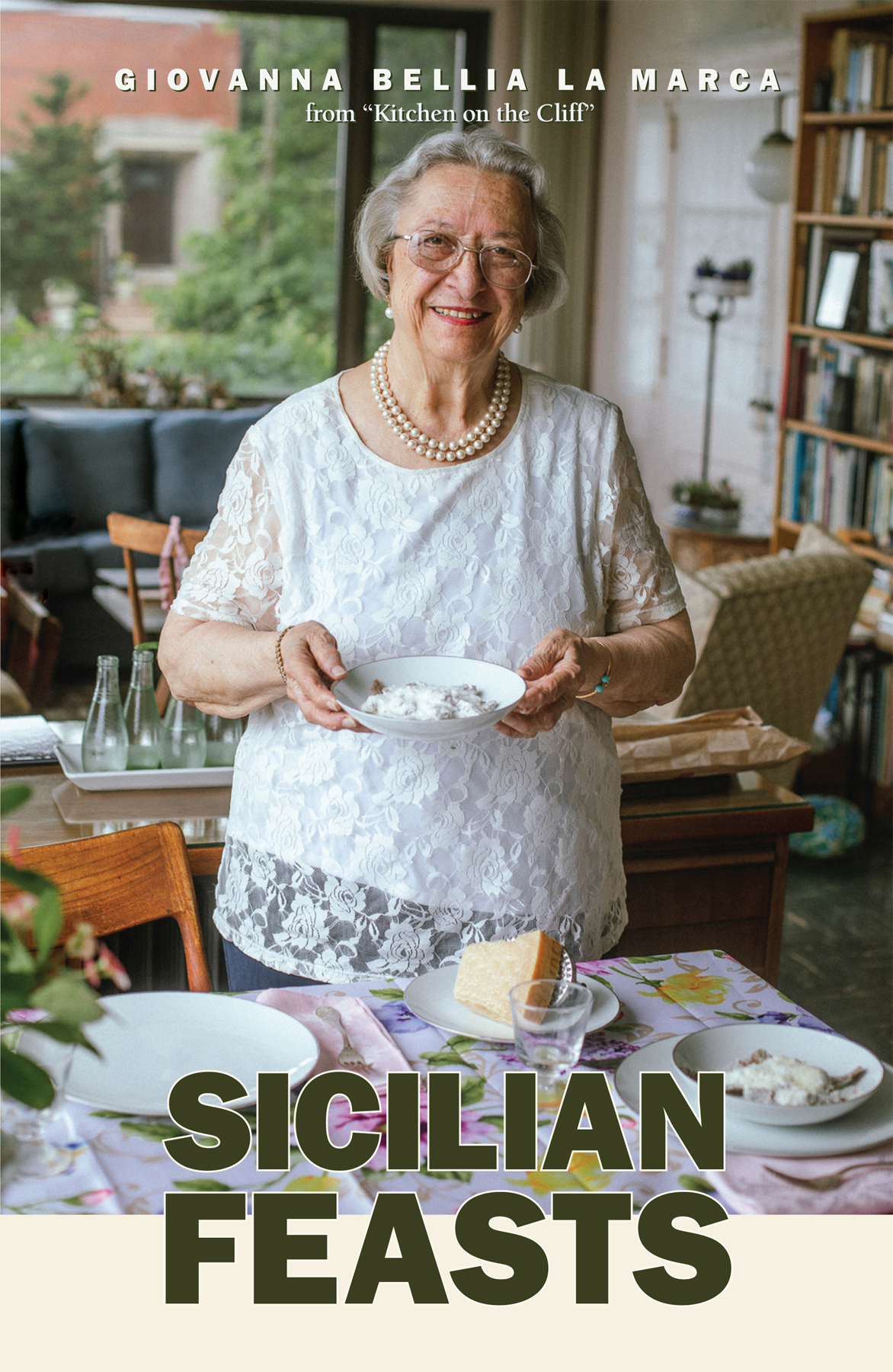Contents
List of Figures
Guide
Pagebreaks of the Print Version
Also by the author
The Cooking of Emilia-Romagna
Language and Travel Guide to Sicily
SICILIAN FEASTS
ILLUSTRATED EDITION
Giovanna Bellia La Marca
Color photographs by
Francesca La Marca Sacco
HIPPOCRENE BOOKS
NEW YORK
This book is dedicated to the Bellia, Biazzo, Sirugo, La Marca, and Sacco families.
Acknowledgments:
I would like to thank Howard La Marca for his unconditional faith, Nicoletta La Marca Sacco for inspiring me, Steven Sacco for being my computer guru, Felice La Marca Sacco for his invaluable tech support, Francesca La Marca Sacco for her innate creativity in composing the beautiful color photographs for this new edition of Sicilian Feasts, Vicky Bennison for having invited me to make a Pasta Grannies video which led to our Kitchen on the Cliff YouTube Channel, Gary A. Goldberg of The New School University in New York City for showing me the way, and Anne E. McBride, my editor at Hippocrene, for making it happen.
Illustrated Edition, 2022
Copyright 2003, 2014, 2022 Giovanna Bellia La Marca.
All rights reserved.
Color photographs by Francesca La Marca Sacco
Book and jacket design by Acme Klong Design
For more information, address:
Hippocrene Books, Inc.
171 Madison Ave.
New York, NY 10016
www.hippocrenebooks.com
Previous editions ISBN: 978-0-7818-1334-1
Cataloging-in-publication data available from the Library of Congress
ISBN-13: 978-0-7818-1433-1
Printed in the United States of America.
TABLE OF CONTENTS

Ragusa Ponte Vecchio. Ragusa has three bridges: Ponte Nuovo, Ponte Vecchio, and Ponte San Vito. This photograph is taken from Ponte Nuovo and it shows the other two bridges.
PREFACE
To my great delight, my grandmother Concettina Biazzo Bellia allowed me to help her in the kitchen even as a very young child. That was before my family emigrated to the United States from Ragusa, Sicily, when I was 10 years old.
Ragusa is the southernmost city in Sicily, located on a mountain near the point of the triangle, which is the shape of the island, 10 miles from the Mediterranean Sea. Ragusa, together with eight other cities in the nearby area, has been listed by UNESCO, an agency of the United Nations that works to protect cultural and natural treasures in 125 countries, as a World Heritage Site. Ragusa and the other eight towns were destroyed by an earthquake in 1693, so their reconstruction represents important innovations in seventeenth and eighteenth century urban planning. When Ragusa was rebuilt, the plan of the city was created with the modern technique of parallel north-south streets going up the mountain that are perpendicular to the streets going east-west. This is a contrast to the streets of the ancient section of the city, Ragusa Ibla, in which, to this day, the streets follow the contour of the land, and no two are parallel to each other. The earthquake spared the portal of the medieval church of San Giorgio, which still stands and is the symbol of the city. The new church, designed in the baroque style, was built on higher ground on top of a majestic staircase.

Ragusa Ibla Portal of San Giorgio This portal is all that remained standing of the medieval church of San Giorgio after the earthquake of 1693. This portal is the symbol of the city.
Ragusa Ibla hosts an important international music competition, The Ibla Grand Prize, which takes place annually during the last week of June and the first week of July. Under the direction of founder and director Salvatore Moltisanti, a young, energetic and very talented virtuoso of the piano, hundreds of musicians come to Ragusa Ibla from all over the world and perform to a delighted public as they compete for the awards. The winners perform in New York the spring following the competition (see for contact information).
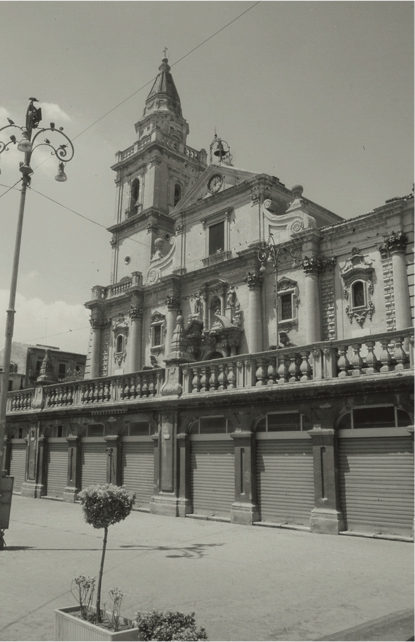
Ragusa Cathedral of San Giovanni
During my childhood in Ragusa, I learned to appreciate the history, the natural beauty, the mystery of the mountains, the beautiful baroque architecture, and the food of a city that has had continued habitation for over two thousand years.
As an adult, I developed a passion for cooking and serving all sorts of dishes, but particularly the food of my birthplace. I have collected, tested, and researched recipes during and after my frequent trips to Italy and to Sicily I have been assisted in this by the generosity of friends and family who have enthusiastically parted with their traditional and treasured family recipes.
In July of 1997, I was asked by the Rotary Club of Ragusa to be part of a three-member jury for a cooking competition between the cities of Ragusa and Modica. The competition was held on a lovely country estate near Modica, and it attracted some of the finest cooks in the southeastern part of Sicily. I felt qualified to be a judge since I was born in Ragusa, and my grandfather Don Giovannino Sirugo, who was an excellent cook, was born in Modica. As my family members tease, I have cooking in my genes!
My father, Felice Bellia, and his mother Concettina were enthusiastic cooks. My maternal grandfathers own father had been a monzu, a professional cook at the Castle of Donnafugata, now a museum, and later at the Monastery of Il Carmine in Ragusa. Monzu, which is a corruption of the French monsieur, was the title earned by a class of professional cooks who developed a very refined and rather elaborate cuisine, and who were employed either by aristocratic families, or by the church. A wealth of recipes and cooking techniques has been handed down to me, which Ive always enjoyed using and would like to share.
Now that more people are traveling to Sicily, I would like to inspire Americans to try some of our delicious traditional recipes, especially the foods they enjoyed while visiting there. Since we are able to get just about any ingredient in the United States, either at local Italian groceries, through mail order, or on the Web, the home cook can be adventurous in trying interesting and even exotic recipes. Most home cooks have labor-saving appliances that the monzu of the eighteenth and nineteenth centuries would have welcomed and used in his kitchen had they been available. It is the availability of ingredients and equipment that makes it possible for the home cook to reproduce even the most elaborate historical dishes.
Cooking has always been central to my life, both for my family, and for my family of friends. Since my professional training is in design, I have always enjoyed presenting even the most humble fare creatively. Sharing cooking techniques and recipes, making suggestions for entertaining, and creating menus for special occasions has led me to compile a cookbook that combines traditional dishes, foods associated with particular feast days, and some of the elaborate dishes from the kitchens of the


